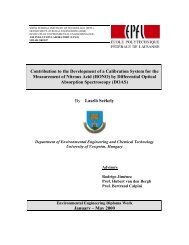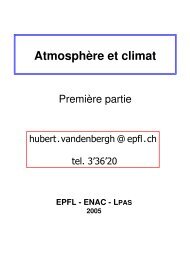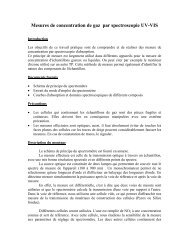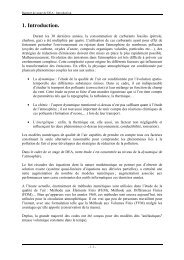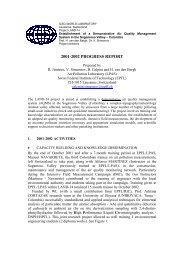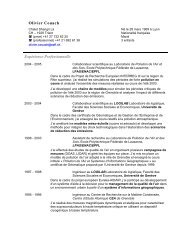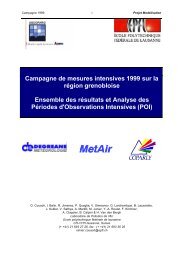Diploma report Implementation and verification of a simple ... - LPAS
Diploma report Implementation and verification of a simple ... - LPAS
Diploma report Implementation and verification of a simple ... - LPAS
You also want an ePaper? Increase the reach of your titles
YUMPU automatically turns print PDFs into web optimized ePapers that Google loves.
5 Conclusion<br />
A two-dimensional finite volume method modeling the Euler equations on a Cartesian grid<br />
was developped. Several types <strong>of</strong> numerical fluxes <strong>and</strong> various time integration methods were<br />
implemented.<br />
The model using Leapfrog time integration <strong>and</strong> central differences in space with initial<br />
hydrostatic equilibrium conditions was found stable for integration times up to ten hours if<br />
a numerical smoothing filter was applied. Sensitivity to numerical filtering was tested using<br />
a one-dimensional model <strong>and</strong> indicated that the oscillations in solutions that occur with<br />
Leapfrog scheme could be controlled using an Asselin time filter. Small-scale noise generated<br />
by numerical dispersion could be reduced by applying <strong>of</strong> a smoothing filter. Results also<br />
indicated that the source term formulation has a important effect on the velocities <strong>of</strong> the<br />
winds generated by numerical imprecisions.<br />
Grid-converged solutions could be obtained for various problems. In one space dimension<br />
the simulation <strong>of</strong> sound waves gave satisfying results for a Gaussian perturbation <strong>and</strong> the<br />
behaviour <strong>of</strong> the numerical solutions is in agreement with physical intuition. In two dimensions,<br />
advection <strong>of</strong> a density perturbation demonstrated the ability <strong>of</strong> the model to reproduce<br />
correct propagation speed. Finally, numerical simulations <strong>of</strong> a density-current test-problem<br />
showed that the model is capable <strong>of</strong> correctly reproducing the essence <strong>of</strong> all the important<br />
physics <strong>of</strong> the flow.<br />
Further improvements can be made by solving the instability problems arising with the<br />
splitting technique. To this end, changes could be done in the splitting method to include the<br />
numerical diffusion term. Besides this the order <strong>of</strong> the time integration can also be improved<br />
using a third-order Runge-Kutta scheme for example. These two modifications should permit<br />
to gain in accuracy.<br />
The numerical model that was developed here was found to work well <strong>and</strong> gave satisfying<br />
results. As next step, the implementation <strong>of</strong> a cut-cell boundary condition can be<br />
performed as this would permit to treat complex topography on the lower boundary.<br />
6 Acknowledgements<br />
A would like to thank Oliver Fuhrer for his help <strong>and</strong> guidance during these four months. I<br />
would also like to thank Alain Clappier for <strong>of</strong>fering me the possibility to do my diploma work<br />
in the <strong>LPAS</strong> group <strong>and</strong> the people in the group for their support.<br />
38



